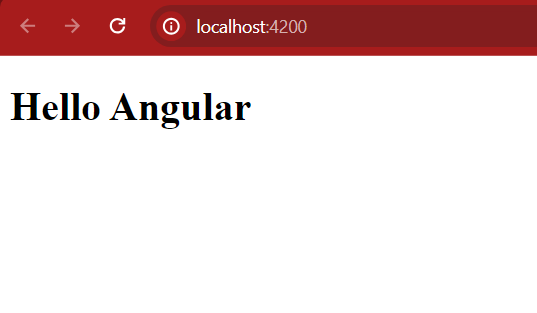What is Angular ?
Last Updated :
12 Apr, 2024
Angular is an open-source web application framework maintained by Google and a community of developers. It is designed to build dynamic and interactive single-page applications (SPAs) efficiently. With Angular, developers can create robust, scalable, and maintainable web applications.
Prerequisites
History
Angular, initially released in 2010 by Google, has undergone significant transformations over the years. The first version, AngularJS, introduced concepts like two-way data binding and directives. However, as web development evolved, AngularJS faced limitations in terms of performance and flexibility.
In 2016, Angular 2 was released, which was a complete rewrite of AngularJS, focusing on modularity and performance. Since then, Angular has continued to evolve, with regular updates and improvements to meet the demands of modern web development.
Why Angular?
JavaScript is the most commonly used client-side scripting language. It is written into HTML documents to enable interactions with web pages in many unique ways. As a relatively easy-to-learn language with pervasive support, it is well-suited to develop modern applications.
But is JavaScript ideal for developing single-page applications that require modularity, testability, and developer productivity? Perhaps not.
These days, we have a variety of frameworks and libraries designed to provide alternative solutions. With respect to front-end web development, Angular addresses many, if not all, of the issues developers face when using JavaScript on its own.
Here are some of the features of Angular
1. Custom Components
Angular enables users to build their components that can pack functionality along with rendering logic into reusable pieces.
2. Data Binding
Angular enables users to effortlessly move data from JavaScript code to the view, and react to user events without having to write any code manually.
3. Dependency Injection
Angular enables users to write modular services and inject them wherever they are needed. This improves the testability and reusability of the same services.
4. Testing
Tests are first-class tools, and Angular has been built from the ground up with testability in mind. You will have the ability to test every part of your application—which is highly recommended.
5. Comprehensive
Angular is a full-fledged JavaScript framework and provides out-of-the-box solutions for server communication, routing within your application, and more.
6. Browser Compatibility
Angular works cross-platform and compatible with multiple browsers. An Angular application can typically run on all browsers (Eg: Chrome, Firefox) and operating systems, such as Windows, macOS, and Linux.
Creating an Angular Application
Step 1: Install Angular CLI: Angular CLI (Command Line Interface) is a powerful tool for scaffolding and managing Angular applications. Install it globally using npm:
npm install -g @angular/cli
Step 2: Create a New Angular Project: Use Angular CLI to create a new Angular project. Navigate to the desired directory and run:
ng new my-angular-app
Step 3: Navigate to the Project Directory: Move into the newly created project directory:
cd my-angular-app
Step 4: Serve the Application: Launch the development server to see your app in action:
ng serve
Folder Structure:

What is angular
Dependencies:
"dependencies": {
"@angular/animations": "^17.3.0",
"@angular/common": "^17.3.0",
"@angular/compiler": "^17.3.0",
"@angular/core": "^17.3.0",
"@angular/forms": "^17.3.0",
"@angular/platform-browser": "^17.3.0",
"@angular/platform-browser-dynamic": "^17.3.0",
"@angular/router": "^17.3.0",
"rxjs": "~7.8.0",
"tslib": "^2.3.0",
"zone.js": "~0.14.3"
}Example:
HTML
<!-- app.component.html -->
<h1>Hello Angular</h1>
//app.component.ts
import { Component } from '@angular/core';
import { RouterOutlet } from '@angular/router';
@Component({
selector: 'app-root',
standalone: true,
imports: [RouterOutlet],
templateUrl: './app.component.html',
styleUrl: './app.component.css'
})
export class AppComponent {
title = 'my-angular-app';
}
Output:
Upon running `ng serve`, the Angular CLI will compile the application and launch a development server. Open a web browser and navigate to `http://localhost:4200` to view the application running locally.

Features of Angular
- Two-Way Data Binding: Angular provides seamless synchronization between the model and the view, allowing for easy management of user inputs.
- Dependency Injection: Angular’s built-in dependency injection system provides modular development and code reusability.
- Directives: Angular offers a rich set of built-in directives for manipulating the DOM, such as *ngIf*, *ngFor*, and *ngSwitch*.
- Routing: Angular’s powerful routing module enables to build SPAs with multiple views and navigation between them.
- HTTP Client: Angular includes an HTTP client module for making server requests, simplifying data fetching and manipulation.
Advantages of Angular
- Productivity: Angular’s extensive tooling and ecosystem streamline development tasks, enabling faster project completion.
- Maintainability: Angular’s modular architecture and clear separation of concerns promote code organization and maintainability.
- Scalability: Angular is well-suited for building large-scale applications, thanks to its component-based architecture and robust performance.
- Community Support: Being backed by Google and a vast community of developers, Angular enjoys strong community support and continuous improvement.
Disadvantages of Angular
- Learning Curve: Angular has a steep learning curve, especially for beginners, due to its complex concepts and extensive documentation.
- Performance Overhead: Angular’s powerful features come with a performance cost, and poorly optimized applications may suffer from performance issues.
- Size: Angular applications tend to have larger file sizes compared to other frameworks, which may impact load times, especially on mobile devices.
- Migration: Upgrading between major Angular versions can be challenging and time-consuming, requiring significant changes to existing codebases.
Conclusion
In conclusion, Angular is a robust and feature-rich framework for building modern web applications. With its powerful features, extensive tooling, and strong community support, Angular remains a popular choice for developers aiming to create scalable and maintainable SPAs. Despite its learning curve and performance considerations, Angular offers immense potential for building dynamic and interactive web experiences. Whether you’re a seasoned developer or a newcomer to web development, Angular provides the tools and capabilities to bring your ideas to life.
Share your thoughts in the comments
Please Login to comment...